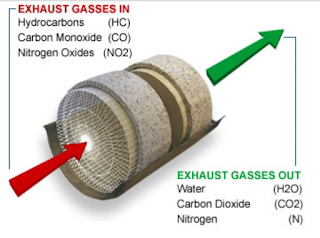The Catalytic Converter
Three major automotive pollutants are carbon monoxide (CO), unburned hydrocarbons (HC), and oxides of nitrogen (NOx). When air and gasoline are mixed and burned in the combustion chambers, the by-products of combustion are carbon, carbon dioxide (CO2), CO, and water vapor. Gasoline is a hydrocarbon fuel containing hydrogen and carbon. Since the combustion process in the cylinders is never 100% complete, some unburned HC are left over in the exhaust. Some HC emissions occur from evaporative sources, such as gasoline tanks and carburetors.
Oxides of nitrogen (NOx) are caused by high cylinder temperature. Nitrogen and oxygen are both present in air. If the combustion chamber temperatures are above 1,371 degrees Celsius, some of the oxygen and nitrogen combine to form NOx. In the presence of sunlight, HC and NOx join to form smog.
Catalytic converters may be pellet-type or monolithic-type. A pellet-type converter contains a bed made from hundreds of small beads, and the exhaust gas passes over this bed (see Fig 1). In a monolithic-type converter, the exhaust gas passes through a honeycomb ceramic block (Fig 2). The converter beads, or ceramic block, are coated with a thin coating of platinum, palladium, or rhodium, and mounted in a stainless steel container. An oxidation catalyst changes HC and CO to CO2 and water vapor (H20). The oxidation catalyst may be referred to as a two-way catalytic converter (Fig 3).
Fig 1: Pellet-type catalytic converter
Fig 2: Monolithic-type catalytic converter
Fig 3: Oxidation catalyst changed HC and CO to CO2
Fig 4: Three-way catalytic converter operation
In a three-way catalytic converter, the converter is positioned in front of the oxidation catalyst. A three-way catalytic converter reduces NOx emissions as well as CO and HC. The three-way catalyst reduces NOx into nitrogen and oxygen (Fig 4).
Some catalytic converters contain a thermo-sensor that illuminates a light on the instrument panel if the converter begins to overheat. Unleaded gasoline must be used in engines with catalytic converters. If leaded gasoline is used, the lead in the gasoline coats the catalyst and makes it ineffective. Under this condition, tail pipe emissions become very high. An engine that is improperly tuned would also cause severe overheating of the catalytic converter. Examples of improper tuning would be a rich air-fuel mixture or cylinder misfiring.
Many catalytic converters have an air hose connected from the belt-driven air pump to the oxidation catalyst. This converter must have a supply of oxygen to operate efficiently. On some engines, a mini-catalytic converter is built into the exhaust manifold or bolted to the manifold flange.
The Resonator, Muffler, and Tailpipe
Since the resonator and muffler perform basically the same functions, I decided to write about them under one heading. Firstly, the main function of the muffler is to reduce the sound of the engine’s outcoming exhaust gases through the exhaust pipes to a minimal level. Since the muffler cannot reduce the noise of the engine by itself, some (if not most) exhaust systems also have a resonator between the catalytic converter and the muffler. Resonators are basically the second muffler, and are usually the "straight through" type.
The muffler quiets the noise of the exhaust by "muffling" the sound waves created by the opening and closing of the exhaust valves. When an exhaust valve opens, it discharges the burned gases at high pressures into the exhaust pipe, which is at low pressure. This type of action creates sound waves that travel through the flowing gas, moving much faster than the gas itself (up to 1400 mph = 625.8m/s), that the resonator and muffler must silence. It generally does this by converting the sound wave energy into heat by passing the exhaust gas and its accompanying wave pattern, through perforated tubes and tuning chambers. Passing into perforations and reflectors within the chamber forces the sound waves to dissipate their energy.
The above described and pictured muffler design is the most common type, the reverse-flow design, which changes the direction of exhaust flow inside the muffler. Exhaust gases are directed to the third chamber, forced forward to the first chamber, from where they travel the length of the muffler and are exhausted into the tailpipe.
Some mufflers are a straight through design in which the exhaust passes through a single perforated pipe into a outside chamber packed with metal, fiberglass, packed glass, or other sound absorbing (or insulating) material. As the exhaust gases expand from the perforated inner pipe into the outer chamber, they come in contact with the insulator and escape to the atmosphere under constant pressure. Because of this, the expanding chamber tends to equalize or spread the pressure peaks throughout the exhaust from each individual cylinder of the engine. This type of muffler is thus freer flowing and designed for the purpose of reducing back pressure and, consequently, makes slightly more noise.
The tail pipe basically carries the flow of exhaust from the muffler to the rear of the vehicle. Some vehicles have an integral resonator in the tail pipe. Like the resonator mentioned earlier, this resonator is similar to a small muffler, and it provides additional exhaust silencing. In some exhaust systems, the resonator is clamped into the tail pipe. Tail pipes have many different bends to fit around the chassis and driveline components. In general, all exhaust systems components must be positioned away from the chassis and driveline to prevent rattling. The tail pipe usually extends under the rear bumper, and the end of this pipe is cut at an angle to deflect the exhaust downward.













